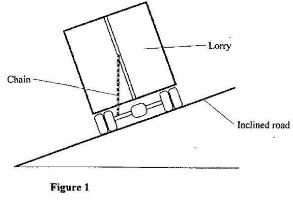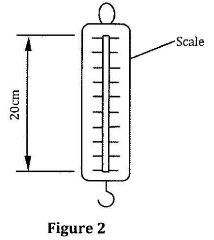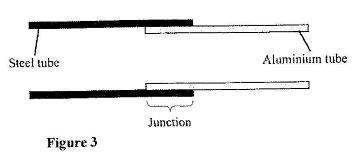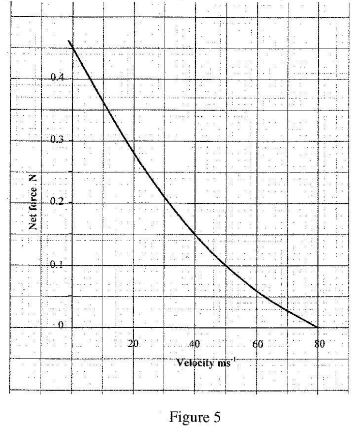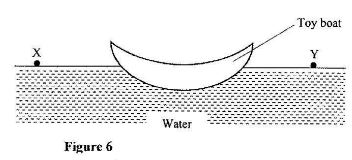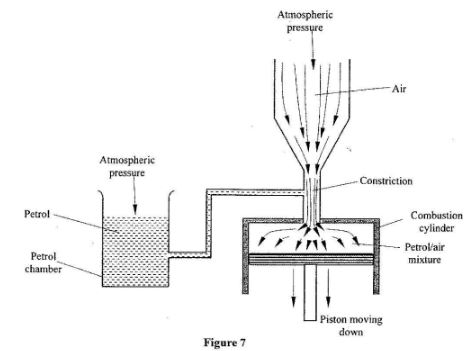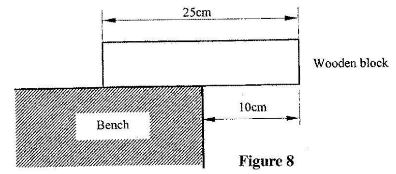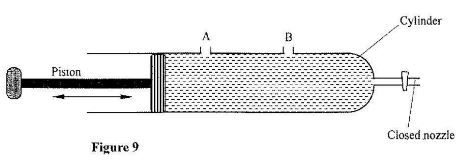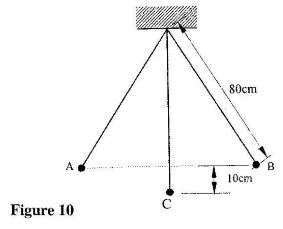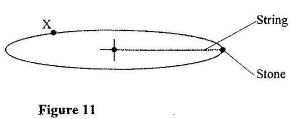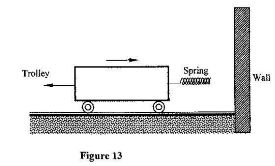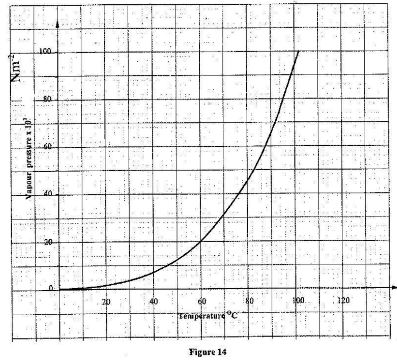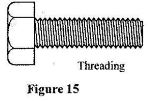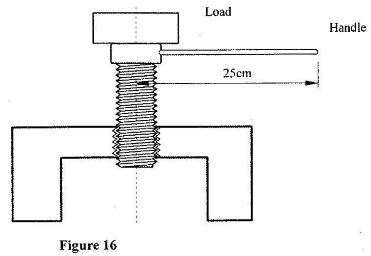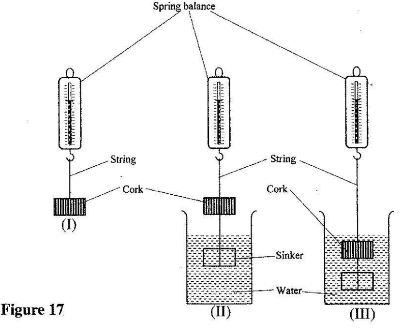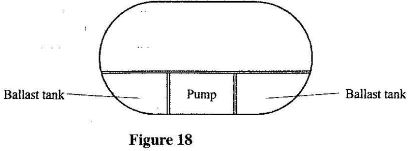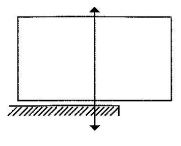SECTION A (25 marks)
Answer all the questions in this section in the spaces provided.
- Figure 1 shows a lorry moving on an inclined section of a straight road. At the back is a chain hanging from a point on a horizontal axis through the centre of gravity of the lorry.
State with a reason whether the lorry is stable or not stable.(1 mark) - State the constant force that opposes the motion of a stone initially at rest, as it falls through air from a tall building.(1 mark)
- Figure 2 shows a spring balance. It's spring constant is 125Nm-'. The scale spreads over a distance of 20cm.
Determine the maximum weight that can be measured using this spring,(3 marks) - Figure 3 shows an aluminium tube tightly stuck in a steel tube.
Explain how the two tubes can be separated by applying a temperature change at the junction given that aluminium expands more than steel for the same temperature rise.(2 marks) - Figure 4 shows two identical beakers P and Q full of water at 90°C. Two similar cold wet clothes are wrapped, one around the top of P and the other around the bottom of Q.
State with a reason, the beaker in which the water cools faster.(2marks) - Figure 5 is a graph of net force on a body against it's velocity as it falls through a liquid.
Determine the terminal velocity of the body.(1 mark) - Figure 6 shows a small toy boat floating on water in a basin. X and Y are two points near the toy.
When a hot metal rod is dipped into the water at point X, the toy is observed to move towards Y. Explain this observation.(2 marks) - When the temperature of a gas in a closed container is raised, the pressure of the gas increases. Explain how the molecules of the gas cause the increase in pressure.(2 marks)
- Figure 7 shows part of a petrol engine, in which air flowing under atmospheric pressure passes into a constriction, where it mixes with petrol. The mixture then flows into a combustion cylinder.
Explain what causes the petrol to move from the petrol chamber to the air stream in the constriction when the piston is moved downwards. (2 marks) - State the reason why it is easier to separate water into drops than to separate a solid into smaller pieces. (1 mark)
Figure 8 shows a uniform wooden block of mass 2kg and length 25cm lying on a bench. It hangs over the edge of the bench by 10cm. Use the figure to answer questions 11 and 12. - Indicate on the figure two forces acting on the wooden block. (1 mark)
- Determine the minimum force that can be applied on the wooden block to make it turn about the edge of the bench. (2 marks)
- A particle starts from rest and accelerates uniformly in a straight line. After 3 seconds it is 9m from the starting point. Determine the acceleration of the particle.(3 marks)
- Figure 9 shows a syringe full of water. It has two identical holes A and B drilled along it's cylinder. The cylinder nozzle is closed.
State with a reason how the speeds of the jets of water from A and B compare when the piston is pushed into the cylinder.(2 marks) -
-
- Indicate with an arrow, on the path ACB, the direction of the greatest velocity of the bob as it moves from A to B. (1 mark)
- State the form of energy possessed by the pendulum bob at point A. (1 mark)
- Determine:
- the velocity of the bob at point C,(3 marks)
- the tension in the string as the bob passes point C. (take acceleration due to gravity g= 10 m/s)(3 marks)
- After some time, the pendulum comes to rest at point C. State what happens to the energy it initially possessed.(1 mark)
-
- Figure 11 shows a stone attached to the end of a string moving in a horizontal circle with a uniform speed of 2ms!. When the stone reaches point X on the circle, thestring breaks.
-
- Figure 11 Indicate on the diagram with an arrow, the direction of the motion of the stone when the string breaks. (1 mark)
- State the magnitude of the velocity after the string breaks.(1 mark)
- Give a reason for your answers in (i) and (ii).(1 mark
- Figure 12 shows a lorry towing a trailer using a rope.
The lorry exerts a force N on the trailer and the trailer exerts an equal but opposite force M on the lorry. The frictional force between the trailer and the road is F.
Explain how the forces N, M and F enable the trailer to move,(2 marks) - Figure 13 shows a frictionless trolley of mass 2kg moving with uniform velocity towards a wall. At the front of the trolley is a spring whose spring constant is 25Nm. The trolley comes to rest momentarily after compressing the spring by 3cm and then rebounds from the wall.
- Determine
- the force exerted on the wall by the spring. (3 marks)
- the maximum acceleration of the trolley as it rebounds from the wall. (3 marks)
- State the reason why the trolley acquires a constant velocity after it rebounds. (2 marks)
- Determine
-
-
- When the temperature of water reaches the boiling point, bubbles rise to the surface.
- State what is contained in the bubbles. (1 mark)
- State the reason why bubbles rise to the surface only at the boiling point. (1 mark)
- Figure 14 shows a graph of vapour pressure against the temperature of water vapour, in a laboratory where a mercury barometer indicates a height of 61.8 cm.
- Determine the atmospheric pressure in the laboratory in Nm.
(Take g = 10m/s2 and density of mercury = 13600 kg/m?). (3 marks) - Use the graph to determine the boiling point of water in the laboratory. (1 mark)
- Determine the atmospheric pressure in the laboratory in Nm.
- In an experiment to determine the specific heat capacity of a metal, a 100g of the metal was transferred from boiling water to a lagged copper calorimeter containing cold water. The water was stirred and a final steady temperature was realized. The following data was recorded.
Initial temperature of cold water and calorimeter = 20°C.
Temperature of boiling water = 99°C.
Final temperature of water, calorimeter and the metal = 27.7°C.
Mass of cold water and calorimeter = 130g.
Mass of calorimeter = 50g.
(Take specific heat capacity of water as 4200Jkg K-)
(Specific heat capacity of copper as 400Jkg-K-').
Use the data to determine:- the heat ca the heat gained by the water and the calorimeter,(3 marks)
- the specific heat capacity of the metal.(3 marks)
- State one possible source of error in the value of the specific heat capacity obtained in the experiment. (a) Figure 15 shows a metal bolt which is threaded. (1 mark)
- When the temperature of water reaches the boiling point, bubbles rise to the surface.
-
- Figure 15 shows a metal bolt which is threaded
Explain how a metre rule can be used to measure the pitch (distance between adjacent peaks) of the threading. (2 marks) - Figure 16 shows a screw jack whose screw has a pitch of 1mm, and has a handle of 25 cm long.
Determine the velocity ratio of the jack.(3 marks) - A bullet of mass 60g travelling at 800mshits a tree and penetrates a depth of 15 cm before coming to rest.
- Explain how the energy of the bullet changes as it penetrates the tree. (1 mark)
- determine the average retarding force on the bullet.(3 marks)
- Figure 15 shows a metal bolt which is threaded
-
- State the condition necessary for a body to float in a fluid.(1 mark)
- A ship made of steel is observed to float on water yet the density of steel is approximately eight times that of water. Explain this observation.(2 marks)
- Figure 17 shows three stages of an experiment to determine relative density of cork which normally floats on water. To make it sink, a sinker is hung below the cork.
In (I) a spring balance is used to measure the weight W of the cork in air. In (II) the spring balance is used to measure the apparent weight W, when only the sinker is submerged in water,
In (III) the spring balance is used to measure the apparent weight W, when both the cork and the sinker are submerged.
The following observations were made.
W = 0.08N
W1=0.60N
W2=0.28N
Use this information to determine the:- upthrust on cork.(2 marks)
- relative density of cork.(3 marks)
- Figure 18 shows parts of a simple submarine, a ship that can travel both on water and under water. To do this water is pumped in or out of the ballast tanks.
Explain how the tanks are used to change the depth of the submarine. (2 marks)
MARKING SCHEME
- Stable
Line through the centre of gravity is within the base the base of the lorry; - Upthrust;
- F = ke
= 125 x 0.2;
= 25N ; - Cooling;
Aluminium contracts more than steel for the same temperature change; - P:
Cool layers from top descend and are replaced by hotter layers, convection starts from top: - Terminal velocity = 80 m/s;
- Surface tension at X is reduced;
Higher surface tension at Y pulls the boat; - Speed of molecules increases;
Molecules hit walls more frequently with greater momentum. - Velocity at constriction is higher;
Pressure drops, atmospheric pressure pushes petrol to the constriction - Smaller intermolecular forces in liquids than solids.
- Reaction
- 20 x 2.5 = F x 10;
F = 20 x 2.5
10
5 N; - S= 1/2at2:
9= 1/2ax 32.
a = 2 ms-2. - Identical jets:
Pressure is transmitted equally throughout the liquid. -
-
- Arrow tangent at C
- Potential energy.
-
- Mgh = 1/2mv2:
v= √2 x 10 x 0.1:
= 1.41 ms-1: - Tension = mv2/r + mg
0.05/0.8 x 2 +0.05 x 10; = 0.625 N;
- Mgh = 1/2mv2:
- Used to do work against air resistance;
Converted to heat energy.
-
-
-
- tangent at X;
- 2 m/s:
- obeys Newton's first law of motion.
- N>F:
m does not act on the trailer ;
F = Ke; -
-
- F = 25 Nm-1 x 0.03 m;
= 0.75 N. - F = ma:
0.75 = 2 x a;
a = 0.375 m/s2:
- F = 25 Nm-1 x 0.03 m;
- Force in spring decreases as spring recovers original length;
No force on the trolley after contact with wall is lost.
-
-
-
-
- Water vapour
- Vapour pressure at boiling point equals or exceeds prevailing external pressure.
-
- Prevailing atmospheric pressure P= δgh.;
= 13600 x 10 x 0.618;
= 84.0 x 103 Nm-2: - Reading of boiling point pressure at pressure P= 84 x 103 is
95 ±1°C;
- Prevailing atmospheric pressure P= δgh.;
-
- Heat gained by water + heat gained by calorimeter = 0.08 x 4200 x 7.7: +0,05 x 400 x 7.7;
= 2741.21; - Heat lost by metal = heat gained by water and calorimeter
0.1 x 71.3 x C = 2741.2;
2741.2
7.13
= 384.46
≈384 J Kg-1k-1: - metal cooling in the process of transferring:
Metal carrying some hot water into the cold water (any 1 correct)
- Heat gained by water + heat gained by calorimeter = 0.08 x 4200 x 7.7: +0,05 x 400 x 7.7;
-
-
- Measure length of threaded part;
Divide the length by number of threads; - Distance moved by effort = 2Πr cm = 50Π cm;
Distance moved by load = 0.1 cm.
Velocity ratio =Effort distance,
Load distance
50Π
0.1
= 1570.7963
= 1571: - From kinetic energy to heat and sound:
KE = the work done against friction:
1/2 x 0.06 x 800 x 800 = F x 0.15;
F = 12800N:
- Measure length of threaded part;
-
- Upthrust = it's weight
OR weight of fluid displaced by body equals the weight of the body:
OR It's density in less than that of fluid. - Ship has a large air space;
Average density of ship is less than density of water; - To sink, water is allowed into ballast tanks;
To float, pumps are used to expel water from the ballast tanks: -
- Upthrust = W1-W2;
= (0.60 -0.28)
= 0.32 N; - Relative density =
weight of substance
weight of equal volume of water
= 0.08/0.39
= 0.25
- Upthrust = W1-W2;
- Upthrust = it's weight
Join our whatsapp group for latest updates
Tap Here to Download for 50/-
Get on WhatsApp for 50/-
Download KCSE 2011 Physics Paper 1 Questions with Marking Scheme.
Tap Here to Download for 50/-
Get on WhatsApp for 50/-
Why download?
- ✔ To read offline at any time.
- ✔ To Print at your convenience
- ✔ Share Easily with Friends / Students

